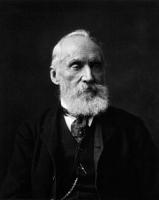| www.tmatlantic.com
Test & Soldering Equipment On-line Store |
|
D.E.V.I.C.E. (Wiki)Calculators Services |
|||||
Filter by first letter
|
William Thomson, 1st Baron Kelvin
William Thomson, 1st Baron Kelvin OM, GCVO, PC, PRS, PRSE, (26 June 1824 – 17 December 1907) was a mathematical physicist and engineer. At the University of Glasgow he did important work in the mathematical analysis of electricity and formulation of the first and second laws of thermodynamics, and did much to unify the emerging discipline of physics in its modern form. He worked closely with mathematics professor Hugh Blackburn in his work. He also had a career as an electric telegraph engineer and inventor, which propelled him into the public eye and ensured his wealth, fame and honour. For his work on the transatlantic telegraph project he was knighted by Queen Victoria, becoming Sir William Thomson. He had extensive maritime interests and was most noted for his work on the mariner's compass, which had previously been limited in reliability. Lord Kelvin is widely known for realising that there was a lower limit to temperature, absolute zero; absolute temperatures are stated in units of kelvin in his honour. On his ennoblement in 1892 in honour of his achievements in thermodynamics, and of his opposition to Irish Home Rule, he adopted the title Baron Kelvin of Largs and is therefore often described as Lord Kelvin. He was the first UK scientist to be elevated to the House of Lords. The title refers to the River Kelvin, which flows close by his laboratory at the University of Glasgow. His home was the imposing red sandstone mansion Netherhall, in Largs on the Firth of Clyde. Despite offers of elevated posts from several world renowned universities Lord Kelvin refused to leave Glasgow, remaining Professor of Natural Philosophy for over 50 years, until his eventual retirement from that post. The Hunterian Museum at the University of Glasgow has a permanent exhibition on the work of Lord Kelvin including many of his original papers, instruments and other artefacts. Find more on http://en.wikipedia.org/wiki/William_Thomson,_1st_Baron_Kelvin |
Measurement History Events
|
Site mapPrivacy policyTerms of Use & Store PoliciesHow to BuyShippingPayment




|

























